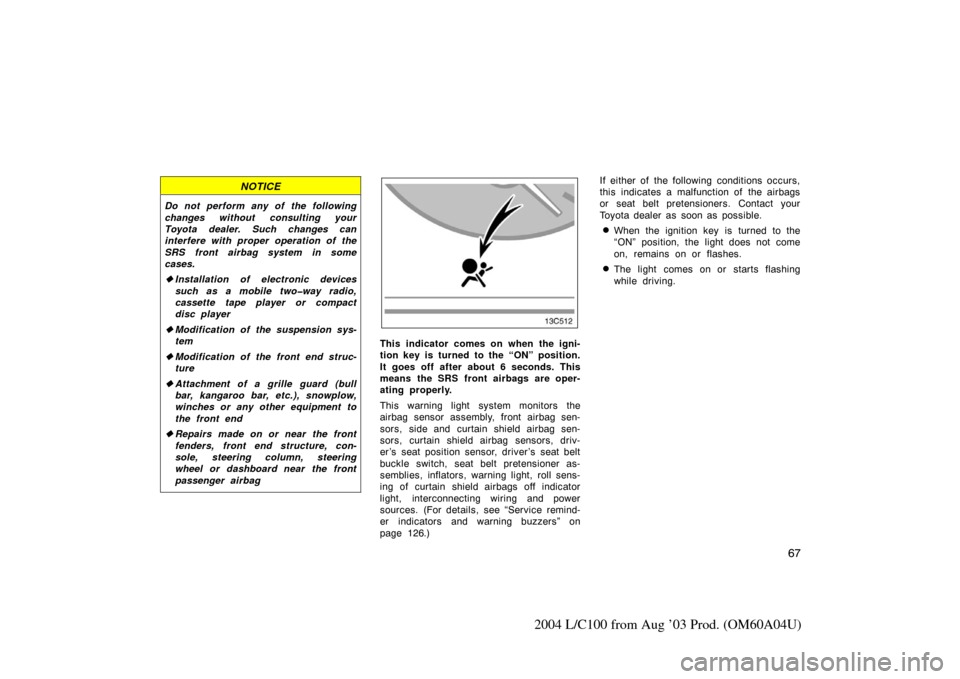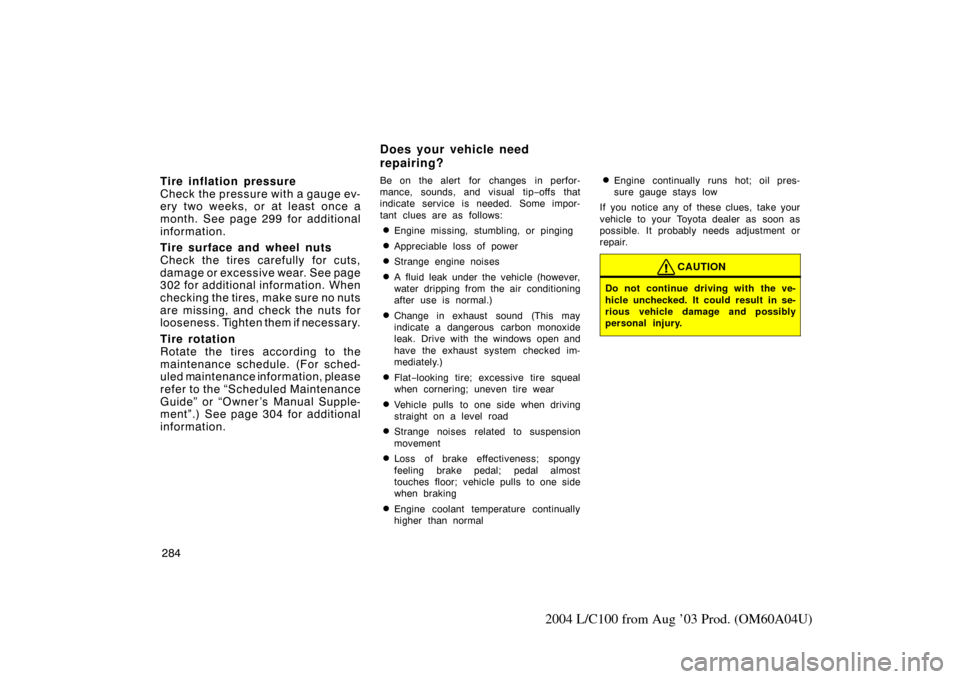Page 75 of 342

67
2004 L/C100 from Aug ’03 Prod. (OM60A04U)
NOTICE
Do not perform any of the following
changes without consulting your
Toyota dealer. Such changes can
interfere with proper operation of the
SRS front airbag system in some
cases.
�Installation of electronic devices
such as a mobile two�way radio,
cassette tape player or compact
disc player
� Modification of the suspension sys-
tem
� Modification of the front end struc-
ture
� Attachment of a grille guard (bull
bar, kangaroo bar, etc.), snowplow,
winches or any other equipment to
the front end
� Repairs made on or near the front
fenders, front end structure, con-
sole, steering column, steering
wheel or dashboard near the front
passenger airbag
This indicator comes on when the igni-
tion key is turned to the “ON” position.
It goes off after about 6 seconds. This
means the SRS front airbags are oper-
ating properly.
This warning light system monitors the
airbag sensor assembly, front airbag sen-
sors, side and curtain shield airbag sen-
sors, curtain shield airbag sensors, driv-
er ’s seat position sensor, driver ’s seat belt
buckle switch, seat belt pretensioner as-
semblies, inflators, warning light, roll sens-
ing of curtain shield airbags off indicator
light, interconnecting wiring and power
sources. (For details, see “Service remind-
er indicators and warning buzzers” on
page 126.) If either of the following conditions occurs,
this indicates a malfunction of the airbags
or seat belt pretensioners. Contact your
Toyota dealer as soon as possible.
�When the ignition key is turned to the
“ON” position, the light does not come
on, remains on or flashes.
�The light comes on or starts flashing
while driving.
Page 246 of 342

238
2004 L/C100 from Aug ’03 Prod. (OM60A04U)
�After driving through tall grass,
mud, rock, sand, rivers, etc., check
that there is no grass, bush, paper,
rags, stone, sand, etc. adhering or
trapped on the underbody. Clear
off any such matter from the under-
body. If the vehicle is used with
these materials trapped or adhering
to the underbody, a breakdown or
fire could occur.
�In a rollover crash, an unbelted per-
son is significantly more likely to
die than a person wearing a seat
belt. Therefore, the driver and all
passengers should fasten their seat
belts whenever the vehicle is mov-
ing.
�When driving off�road or in rugged
terrain, do not drive at excessive
speeds, jump, make sharp turns,
strike objects, etc. This may cause
loss of control or vehicle rollover
causing death or serious injury.
You are also risking expensive dam-
age to your vehicle’s suspension
and chassis.
NOTICE
�If driving through water, such as
when crossing shallow streams,
first check the depth of the water
and the bottom of the river bed for
firmness. Drive slowly and avoid
deep water.
� Take all necessary safety measures
to ensure that water damage to the
engine or other components does
not occur.
� Water entering the engine air intake
will cause severe engine damage.
� Water can wash the grease from
wheel bearings, causing rusting and
premature failure, and may also en-
ter the differentials, transmission
and transfer case, reducing the gear
oil’s lubricating qualities.
� Sand and mud that has accumulated
in brake drums and around brake
discs may affect braking efficiency
and may damage brake system com-
ponents.
�Always perform a maintenance in-
spection after each day of off�road
driving that has taken you through
rough terrain, sand, mud, or water.
For scheduled maintenance informa-
tion, refer to the “Scheduled Main-
tenance Guide” or “Owner’s Manual
Supplement”.
Page 292 of 342

284
2004 L/C100 from Aug ’03 Prod. (OM60A04U)
Tire inflation pressure
Check the pressure with a gauge ev-
ery two weeks, or at least once a
month. See page 299 for additional
information.
Tire surface and wheel nuts
Check the tires carefully for cuts,
damage or excessive wear. See page
302 for additional information. When
checking the tires, make sure no nuts
are missing, and check the nuts for
looseness. Tighten them if necessary.
Tire rotation
Rotate the tires according to the
maintenance schedule. (For sched-
uled maintenance information, please
refer to the “Scheduled Maintenance
Guide” or “Owner ’s Manual Supple-
ment”.) See page 304 for additional
information.Be on the alert for changes in perfor-
mance, sounds, and visual tip −offs that
indicate service is needed. Some impor-
tant clues are as follows:
�Engine missing, stumbling, or pinging
�Appreciable loss of power
�Strange engine noises
�A fluid leak under the vehicle (however,
water dripping from the air conditioning
after use is normal.)
�Change in exhaust sound (This may
indicate a dangerous carbon monoxide
leak. Drive with the windows open and
have the exhaust system checked im-
mediately.)
�Flat −looking tire; excessive tire squeal
when cornering; uneven tire wear
�Vehicle pulls to one side when driving
straight on a level road
�Strange noises related to suspension
movement
�Loss of brake effectiveness; spongy
feeling brake pedal; pedal almost
touches floor; vehicle pulls to one side
when braking
�Engine coolant temperature continually
higher than normal
�Engine continually runs hot; oil pres-
sure gauge stays low
If you notice any of these clues, take your
vehicle to your Toyota dealer as soon as
possible. It probably needs adjustment or
repair.
CAUTION
Do not continue driving with the ve-
hicle unchecked. It could result in se-
rious vehicle damage and possibly
personal injury.
Does your vehicle need
repairing?